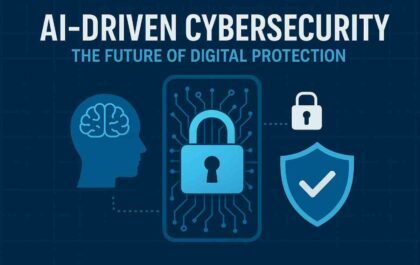In today’s hyper-connected world, cyber threats are evolving at an unprecedented pace. From sophisticated phishing campaigns to large-scale ransomware attacks, businesses and individuals face digital risks every single day. As traditional security systems struggle to keep up, AI-driven cybersecurity has emerged as a powerful solution — intelligent, adaptive, and built for the future.
SmartTechCrunch explores how artificial intelligence is reshaping digital protection.
Table of Contents
What Is AI-Driven Cybersecurity?
AI-driven cybersecurity refers to the use of artificial intelligence and machine learning technologies to detect, analyze, and respond to cyber threats. Unlike manual systems or rule-based software, AI can:
-
Learn from past patterns
-
Predict new attack behaviors
-
Detect anomalies in real time
-
Automate threat responses
This makes it far more advanced than conventional security tools, especially in environments where huge amounts of data need to be monitored.
Why AI Is Becoming Essential
1. Cyber Attacks Are Increasing Rapidly
Hackers now use automation, bots, and AI tools themselves — making cybercrime faster and more complex. Traditional systems cannot analyze millions of data points instantly, but AI can.
2. AI Reduces Human Error
Many breaches occur due to delayed human response or mistakes.
AI automates detection and alerts, lowering the chance of oversight.
3. Real-Time Threat Detection
AI monitors networks continuously.
When it notices unusual behavior — such as unknown login locations or suspicious file movements — it acts immediately.
4. Smart Prediction Capabilities
Machine learning allows systems to predict attacks before they fully occur, helping businesses stay one step ahead of hackers.
Key Features of AI-Powered Security Systems
Automated Response
AI doesn’t just detect threats — it can automatically isolate infected devices, block malicious IPs, or send instant alerts without human intervention.
Behavioral Analysis
AI studies user behavior patterns. If activity deviates from normal usage, it triggers security actions.
Fraud Detection
Banks, e-commerce platforms, and digital wallets use AI to identify suspicious transactions and fake accounts.
Adaptive Learning
The more data AI processes, the smarter it becomes, constantly improving its defense strategies.
How Industries Are Using AI for Protection
Finance Sector
Banks leverage AI to fight fraud, secure transactions, and recognize abnormal spending patterns.
Healthcare
Hospitals use AI to secure patient data, prevent ransomware attacks, and detect unauthorized access.
Small and Large Businesses
From startups to multinational companies, AI-based security tools help organizations protect customer data, emails, endpoints, and cloud systems.
Challenges of AI in Cybersecurity
While incredibly powerful, AI also poses challenges:
-
AI systems can be expensive for small businesses
-
Hackers can train malware to bypass AI detection
-
Continuous updates and retraining are necessary
However, as technology evolves, these limitations are steadily diminishing.
The Future of Cybersecurity Is Intelligent
The world is moving toward fully automated, intelligent defense systems. AI-driven cybersecurity will play a massive role in:
-
Preventing large-scale cyber attacks
-
Protecting critical infrastructure
-
Securing personal and business data
-
Strengthening global digital safety
For readers of SmartTechCrunch, staying informed about AI advancements is essential — because the next era of cybersecurity isn’t just reactive, it’s predictive and proactive.
AI-Driven Cybersecurity: The Future of Digital Protection
Related posts
Featured Posts
AI-Driven Cybersecurity: The Future of Digital Protection
In today’s hyper-connected world, cyber threats are evolving at an unprecedented pace. From sophisticated phishing campaigns to large-scale ransomware attacks,…
AI Workflow Automation Tools
In a world where speed, accuracy, and efficiency define success, AI workflow automation tools have become essential for businesses of…


